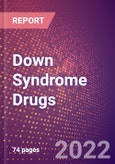1h Free Analyst Time
This pipeline guide Down Syndrome Drugs in Development by Stages, Target, MoA, RoA, Molecule Type and Key Players, 2022 Update, provides an overview of the Down Syndrome (Genetic Disorders) pipeline landscape.Speak directly to the analyst to clarify any post sales queries you may have.
Down syndrome is a genetic disorder that causes lifelong mental retardation, developmental delays and other problems. Down syndrome varies in severity, so developmental problems range from moderate to serious. Children with Down syndrome have a distinct facial appearance. Though not all children with Down syndrome have the same features, some of the more common features are flattened facial features, small head, short neck, protruding tongue, upward slanting eyes, unusual for the child's ethnic group and unusually shaped ears. Children with Down syndrome may also have poor muscle tone, broad, short hands with a single crease in the palm, relatively short fingers and excessive flexibility.
Report Highlights
This pipeline guide Down Syndrome Drugs in Development by Stages, Target, MoA, RoA, Molecule Type and Key Players, 2022 Update, provides comprehensive information on the therapeutics under development for Down Syndrome (Genetic Disorders), complete with analysis by stage of development, drug target, mechanism of action (MoA), route of administration (RoA) and molecule type. The guide covers the descriptive pharmacological action of the therapeutics, its complete research and development history and latest news and press releases.
The Down Syndrome (Genetic Disorders) pipeline guide also reviews of key players involved in therapeutic development for Down Syndrome and features dormant and discontinued projects. The guide covers therapeutics under Development by Companies /Universities /Institutes, the molecules developed by Companies in Phase III, Phase I, Preclinical, Discovery and Unknown stages are 1, 5, 10, 3 and 1 respectively. Similarly, the Universities portfolio in Preclinical and Discovery stages comprises 3 and 2 molecules, respectively.
Down Syndrome (Genetic Disorders) pipeline guide helps in identifying and tracking emerging players in the market and their portfolios, enhances decision making capabilities and helps to create effective counter strategies to gain competitive advantage. The guide is built using data and information sourced from proprietary databases, company/university websites, clinical trial registries, conferences, SEC filings, investor presentations and featured press releases from company/university sites and industry-specific third party sources. Additionally, various dynamic tracking processes ensure that the most recent developments are captured on a real time basis.
Note: Certain content / sections in the pipeline guide may be removed or altered based on the availability and relevance of data.
Scope
- The pipeline guide provides a snapshot of the global therapeutic landscape of Down Syndrome (Genetic Disorders).
- The pipeline guide reviews pipeline therapeutics for Down Syndrome (Genetic Disorders) by companies and universities/research institutes based on information derived from company and industry-specific sources.
- The pipeline guide covers pipeline products based on several stages of development ranging from pre-registration till discovery and undisclosed stages.
- The pipeline guide features descriptive drug profiles for the pipeline products which comprise, product description, descriptive licensing and collaboration details, R&D brief, MoA & other developmental activities.
- The pipeline guide reviews key companies involved in Down Syndrome (Genetic Disorders) therapeutics and enlists all their major and minor projects.
- The pipeline guide evaluates Down Syndrome (Genetic Disorders) therapeutics based on mechanism of action (MoA), drug target, route of administration (RoA) and molecule type.
- The pipeline guide encapsulates all the dormant and discontinued pipeline projects.
- The pipeline guide reviews latest news related to pipeline therapeutics for Down Syndrome (Genetic Disorders)
Reasons to Buy
- Procure strategically important competitor information, analysis, and insights to formulate effective R&D strategies.
- Recognize emerging players with potentially strong product portfolio and create effective counter-strategies to gain competitive advantage.
- Find and recognize significant and varied types of therapeutics under development for Down Syndrome (Genetic Disorders).
- Classify potential new clients or partners in the target demographic.
- Develop tactical initiatives by understanding the focus areas of leading companies.
- Plan mergers and acquisitions meritoriously by identifying key players and it’s most promising pipeline therapeutics.
- Formulate corrective measures for pipeline projects by understanding Down Syndrome (Genetic Disorders) pipeline depth and focus of Indication therapeutics.
- Develop and design in-licensing and out-licensing strategies by identifying prospective partners with the most attractive projects to enhance and expand business potential and scope.
- Adjust the therapeutic portfolio by recognizing discontinued projects and understand from the know-how what drove them from pipeline.
Table of Contents
IntroductionReport CoverageOverviewDormant ProjectsDiscontinued ProductsProduct Development Milestones
Therapeutics Development
Therapeutics Assessment
Companies Involved in Therapeutics Development
Drug Profiles
Featured News & Press Releases
Appendix
List of Tables
Down Syndrome - Discontinued Products
List of Figures
Companies Mentioned (Partial List)
A selection of companies mentioned in this report includes, but is not limited to:
- AC Immune SA
- Aelis Farma SAS
- Alzheon Inc
- Annovis Bio Inc
- Avanti Biosciences Inc
- Balance Therapeutics Inc
- Eisai Co Ltd
- Elixirgen Therapeutics Inc
- F. Hoffmann-La Roche Ltd
- Felicitex Therapeutics Inc
- KinoPharma Inc
- Laminar Pharmaceuticals SA
- Les Laboratoires Servier SAS
- ManRos Therapeutics
- NeuroCircuit Therapeutics Inc
- NeuroNascent Inc
- Perha Pharmaceuticals SAS
- Prothena Corp Plc
- SanBio Co Ltd








